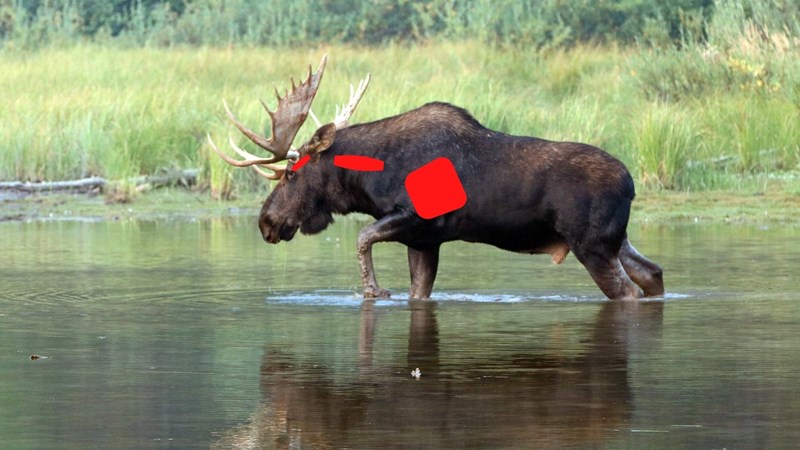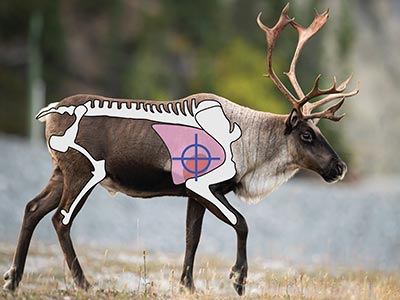For shot placement on a moose, aim for the vitals behind the front shoulder area. To ensure a clean and ethical shot, target the heart and lungs for a quick and humane kill.
When hunting moose, accurate shot placement is crucial for a successful harvest and to prevent unnecessary suffering. By understanding the anatomy of a moose and practicing your marksmanship skills, you can improve your chances of making a precise shot. Proper shot placement also helps with tracking and recovering the animal efficiently after the shot.
Remember to always prioritize ethical hunting practices and respect for the wildlife you pursue.
Understanding Moose Anatomy
Moose hunting requires a precise understanding of moose anatomy to ensure successful shot placement. Vital organs and bone structure play a crucial role in determining where to aim.
Vital Organs
- Heart: Located low in the chest, directly behind the front leg.
- Lungs: Fill the chest cavity and are essential for respiration.
- Liver: Positioned in the abdominal region, crucial for metabolism.
Bone Structure
- Ribcage: Protects vital organs and can deflect bullets, aim for heart/lungs.
- Shoulder Blade: Thickest bone, targeting this area can hinder a quick kill shot.
- Spine: Vital for motor function, avoiding a spine shot is advised.
Understanding the moose’s anatomy, including vital organs and bone structure, is imperative for ethical hunting. Proper shot placement is key to humane and effective hunting practices.
Factors Affecting Shot Placement
Understanding the factors affecting shot placement on a moose is crucial for a successful hunting experience. Proper knowledge of distance, angle, and mental state can significantly impact the outcome of your shot. Let’s delve into these factors to ensure a precise and ethical shot when targeting a moose.
- Optimal shooting distance is usually within 100 yards.
- Increased distance can lead to decreased accuracy and effectiveness.
- Consider the trajectory of the bullet at different distances.
- Shot placement can vary based on the angle of the target.
- Broadside shots offer the best opportunity for a clean kill.
- Avoid shooting at extreme angles to prevent wounded animals.
- Stay calm and focused when taking the shot.
- Manage your stress levels to ensure steady aim.
- Maintain a clear mind to make quick and accurate decisions.
Recommended Shot Placements
Moose hunting requires precise shot placement to ensure a quick and ethical kill. Knowing the recommended shot placements for a moose is crucial for hunters. Proper shot placement ensures the moose is taken down swiftly and humanely, minimizing suffering. In this guide, we’ll discuss the three recommended shot placements for hunting moose: Broadside Shot, Quartering Away Shot, and Head-On Shot.
Broadside Shot
A broadside shot is when the moose is standing perpendicular to the hunter, presenting a wide target area. The recommended shot placement for a broadside moose is behind the front shoulder, aiming for the heart and lung area. This shot ensures maximum organ damage and a quick, effective kill.
Quartering Away Shot
A quartering away shot occurs when the moose is angled away from the hunter but still offers a decent target. When taking a quartering away shot, the ideal placement is behind the last rib, aiming for the opposite shoulder. This shot angle allows for penetration through vital organs, leading to a clean kill.
Head-on Shot
With a head-on shot, the moose is directly facing the hunter, making it a challenging but sometimes necessary shot placement. When facing a head-on moose, the recommended shot is to aim for the center of the chest between the front legs. This angle provides the best chance of hitting vital organs and causing a swift termination.

Credit: www.rifleshootermag.com
Impact Of Shot Placement On Tracking
When hunting for moose, shot placement plays a crucial role in determining the success of your hunt as well as the ability to track the animal afterward. Proper shot placement ensures quick, humane kills while minimizing the distance the moose may travel before succumbing to its injuries. In this section, we will explore the impact of shot placement on tracking and how it can affect your ability to recover a moose.
Blood Trails
The first sign to look for when tracking a wounded moose is the presence of a blood trail. A well-placed shot on vital organs such as the heart or lungs will result in a distinct blood trail that is easy to follow. Blood trails are typically bright red in color and might contain small frothy bubbles, indicating a lung shot. On the other hand, a poorly placed shot on non-vital areas like the stomach or leg could produce a less substantial blood trail, making it more challenging to track the wounded moose.
Tracking Time
The time it takes to track a wounded moose depends on various factors, including shot placement. A fatally wounded moose shot on vital organs will typically expire within a shorter period, usually no more than a few hundred yards from the point of impact. However, when a shot is poorly placed on non-vital areas, the moose may run for a longer distance before eventually succumbing to its injuries. Therefore, understanding shot placement and its effect on tracking time is essential to increase the chances of a successful recovery.
Shot Placement Considerations For Different Calibers
When it comes to hunting moose, shot placement is crucial for ensuring a humane and ethical kill. The right shot placement can also help maximize the effectiveness of your chosen caliber. In this section, we will discuss shot placement considerations for different calibers, including rifle calibers and bowhunting considerations.
Rifle Calibers
Choosing the appropriate rifle caliber for hunting moose is essential, as it determines the power and effectiveness of your shot. Here are a few shot placement considerations based on different rifle calibers:
.270 Winchester
The .270 Winchester is a popular choice among moose hunters due to its flat trajectory and manageable recoil. When using this caliber, aim for the vitals, which are located just behind the front shoulder. This shot placement will ensure you hit the heart and lungs, resulting in a quick and ethical kill.
.30-06 Springfield
The .30-06 Springfield is a versatile caliber that offers a good balance of power and accuracy. When using this caliber, aim for the heart and lungs, similar to the .270 Winchester. However, due to its slightly larger bullet size, the .30-06 can provide a bit more stopping power, making it a great choice for hunting moose.
.300 Winchester Magnum
The .300 Winchester Magnum is a high-powered caliber that delivers impressive velocity and energy. When using this caliber, aim for the vitals just behind the front shoulder. The increased power of the .300 Win Mag allows for deeper penetration and greater tissue damage, ensuring a clean and efficient kill.
| Rifle Caliber | Shot Placement |
|---|---|
| .270 Winchester | Aim for the vitals just behind the front shoulder. |
| .30-06 Springfield | Aim for the heart and lungs. |
| .300 Winchester Magnum | Aim for the vitals just behind the front shoulder. |
Bowhunting Considerations
Bowhunting for moose requires a different approach compared to rifle hunting. When using a bow, shot placement becomes even more critical, as the margin for error is smaller. Here are some bowhunting considerations for shot placement:
- Avoid quartering-to shots: When a moose is facing you, it’s best to wait for a broadside or quartering-away shot. Quartering-to shots increase the risk of the arrow not reaching the vital organs.
- Aim for the heart and lungs: Similar to rifle hunting, aiming for the vitals is crucial. However, with a bow, the margin for error is smaller, so it’s important to be confident in your shooting ability before taking the shot.
- Wait for the moose to present a good shot opportunity: Patience is key in bowhunting. Waiting for the moose to angle itself properly can significantly increase your chances of a successful shot.
Remember, shot placement is a critical factor in ensuring a clean and ethical kill when hunting moose. Familiarize yourself with the capabilities of your chosen caliber and always strive for accurate and well-placed shots.

Credit: www.norma-ammunition.com

Credit: www.adfg.alaska.gov
Frequently Asked Questions For Shot Placement On A Moose
What Is The Best Shot Placement For A Moose?
The best shot placement for a moose is in the vitals, which include the heart and lungs. Aim for the center of the chest, just behind the shoulder. This shot ensures a quick and humane kill with minimal suffering.
Can You Shoot A Moose In The Head?
While it is technically possible to shoot a moose in the head, it is not recommended. The skull is thick and can deflect bullets, leading to an ineffective shot. It is better to aim for the vitals to ensure a clean kill.
Where Should I Aim On A Moose For A Spine Shot?
Aiming for the spine on a moose is not recommended. The spine is a small target and a miss could lead to injuring the animal without a clean, fatal shot. It is best to aim for the vitals to ensure a quick and humane kill.
Conclusion
In a nutshell, placing your shot correctly on a moose is crucial for a successful hunt. By targeting the vital organs and understanding the moose’s anatomy, you can ensure a clean and ethical kill. Remember to always prioritize the moose’s welfare and practice patience and precision for a humane hunting experience.


